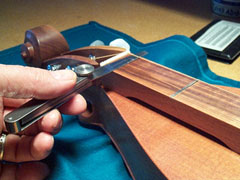Setting the Action
A practical method for setting the Action
Action is the height of the strings above the frets. A dulcimer's ease of playing rests critically on the height of the strings above the frets, or its "action."
Generally, the action at the nut will be just a little higher than the height of the first fret, so there is no buzzing there. Then the height of the saddle is set just a little higher than necessary to avoid any buzzing on the rest of the frets. If the fretboard has been carefully made, that is all there is to action.
You might sometimes find a slight flat area on the tops of some frets. This indicates that the luthier has "joined" the frets to make them more accurately flat with respect to the strings. Joining is the process of leveling the frets with a file, then using a special file called a crowning file to reshape the top of each fret to eliminate the flattened area. This keeps the instrument more accurately in tune and eliminates tiny buzzes that can happen when a string is fretted and buzzes against the fret's flat top. A joined fretboard can also (but not always) indicate that the maker has put the action as low as possible, dressing each fret individually to exactly the same height in order to eliminate buzzing rather than simply raising the action.
Action which is too high can cause an otherwise nicely made instrument to be unplayable, for two reasons. First, it takes more effort to press down the strings. Secondly, the more you have to press the string down, the more you increase the tension. That increase in tension can sharp the note to a surprising degree. The higher the action the more pronounced the sharping. This is an effect of fretting no matter how low the action is, and the process of compensating for it is called "Intonation," which will be our next topic.
I normally set the nut height to .015" higher than the fret crown. For instance, I usually use a .032" crown fret, so I set the nut to hold the strings .047" above the fretboard. To set the saddle end of the action, I do the following before placing the saddle permanently on the instrument:
- Equip instrument with its highest and lowest strings.
- Place a temporary bridge approximately where the bridge is to go. I have made a set a small bone square rods, ranging from .050" to .110" high. On top of this, place a piece of .015" music wire, to serve as a temporary saddle.
- Tune the bass string a whole step lower than the usual tuning. If you ordinarily tune to aAA, then tune to G. This will give the string every chance to buzz.
- With the temporary bridge in place, play a scale all the way up the bass string, noting where any buzzes occur.
- If there is only one place the buzz happens, inspect the next highest fret. It may be too high. If it has come up out of its slot, try knocking it gently back with a light-weight hammer. While doing this tapping, grasp the dulcimer by the edges of the fretboard and hold it a half-inch or so above the table, so the instrument doesn't absorb the full shock of the hammer taps. If this doesn't work, consider filing the fret down slightly.
- After eliminating any single buzzing frets, withdraw the temporary bridge and substitute a slightly lower bone square, which will minutely lower the height of the bass string. Run the scale again. If there are no buzzes, lower the string and repeat until the string begins to buzz against one or more strings. If it buzzes against only one, go back to step 5. If it buzzes against a group of frets, you have found the lower limit of the bass string's height.
- Increase the string's height by moving the inserting a slightly larger (about .010" or so) temporary bridge further under the string, and re-check. If there is still buzzing, keep raising the temporary bridge a little at a time, until there is no more buzzing. If you have to get the strings more than 1/8" above the fretboard at the 17th fret, that is too much--your fretboard may be warped, or you might have frets that weren't properly seated.
- Now check for back buzzes. Fret the bass string IN FRONT of the fret rather than behind it, and pluck the string between the fret and the nut. Any buzzing on the frets is a back buzz, and indicates the nut is too low. Repeat the test for the first six frets. If you find back buzzes, raise the nut .005" and try again.
- When you have eliminated all buzzes on the bass string, mark the position of the string on the wedge of your temporary bridge. This is the saddle height.

